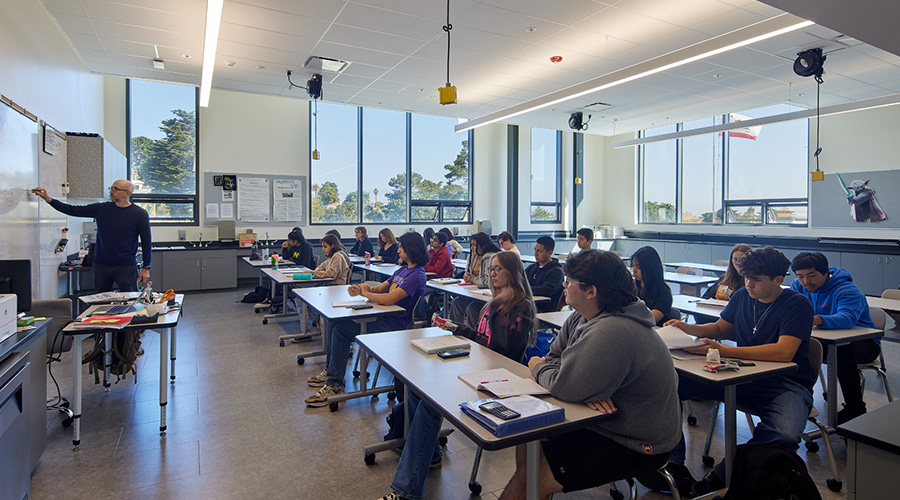The ABCs of K-12 Renovations
Coordinating and carrying out complex building upgrades calls for communication, teamwork and planning
Meeting the ever-changing needs of students and teachers in overcrowded classrooms is an all-too-common challenge for managers in K-12 school districts. While many districts build new facilities to address these problems, more districts focus on renovating existing facilities. Five years ago, Poway (Calif.) Unified School District launched a $198 million bond measure designed to renovate and expand 24 of its 34 schools. An essential element in the success of these projects has been the central role of the district’s maintenance and operations (M&O) department
“I like to think we’re unique at Poway in that the maintenance and operations department is awarded the opportunity to get involved in construction and modernization projects, where a lot of times at other organizations the department is left out,” says Mike Tarantino, the district’s director of maintenance and operations.
The renovations, which are about halfway complete, include upgrading inadequate plumbing and electrical systems, installing new HVAC systems, updating landscaping, and adding classrooms. Throughout the program, the department has performed such critical tasks as helping with equipment specifications, minimizing on-site disruptions, meeting the needs of occupants.
In On the Ground Floor
The department’s 61 maintenance technicians and personnel have been involved in the Building for Success renovation program since its earliest stages.
“When we’re working with the architects on the renovation designs, we also bring in the maintenance and operations staff,” says Mark Claussen, the district’s program manager for bond construction. Claussen and his staff managed the district’s renovation program. During the planning stage, maintenance technicians reviewed the architects’ plans. Giving them the opportunity to participate in the specification process helps ensure renovations will support their ongoing efforts to maintain and operate systems, and it is critical to the project’s success.
“If you don’t engage the maintenance operations staff when you’re putting specifications together, you probably missed a big item,” Claussen says.
Adds Tarantino, “A lot of the new systems have been picked by the M&O staff. They are aware of what is available in new technology and where technology is going.”
Incorporating the maintenance staff’s recommendations for systems and suppliers into renovation plans has been essential for the district’s long-term success.
“There is nothing worse than isolating those guys that are going to have to work on these new systems and give them something that they’re either not familiar with or don’t want to become familiar with,” says Doug Mann, the district’s executive director of facilities.
The process of upgrading facilities performance also tends to run more smoothly when architects and consultants remain part of the planning team throughout the renovation project.
“For the most part, we had the same architects and consultants throughout our modernization designs,” Mann says. “So we don’t have to explain our standards over and over again and what we want for items, such as air conditioning equipment.
“Our priorities include bringing the buildings up to current building codes, complying with current safety requirements, making them all Americans with Disabilities Act accessible, improving our energy efficiency and bringing technology up to current standards,” Mann says.
Updating technology can be difficult, but it can produce a range of benefits. The planning stage also is an appropriate time to address training issues.
“A lot of the heating, ventilation, cooling, and electrical systems are being upgraded for the first time in 15-20 years, and the technology is quite different,” Claussen says. “Before, a maintenance person basically had an on-and-off switch for controlling some building systems. Now, many of these systems feature digital controls and other monitoring systems. As you turn over these new systems to the operators, they need to understand how they work, how they are put together and their maintenance requirements.
“One of the biggest challenges for maintenance organizations right now is that technology for buildings is changing, and training for the staff who maintain these systems is getting more and more important. These systems are complex and technicians can’t learn how to properly maintain them from a tech magazine or a manual any more. They need to take classes and have hands-on time to understand them. So managers need to invest more money into training their maintenance personnel.”
Working with Contractors
One important step during renovations is to establish a cooperative working relationship with contractors.
Claussen’s “staff is part of our team and is going to be with us five to seven years,” Tarantino says, and he encourages the contractors to contact the district’s maintenance technicians with concerns while they are still on the job site. He prefers to find out about potential problems before they leave.
When problems do arise, Tarantino’s department is the first to respond.
“We have so much going on at one time that something is bound to happen,” he says. “The M&O staff has to be prepared to respond to those situations and fit them in with our priorities of maintaining the other schools.”
But aging facilities can complicate the repair and maintenance process.
“Some of these schools are so old that the original blueprints are not very accurate,” Mann says. “So there have been some occasions where we hit electrical lines or water lines because they’re not on the blueprint.”
Say Tarantino, “When that happens, my guys are the first line of defense because often the contractors don’t have a plumber or electrician available. So my guys need to get over there, turn the electricity or water back on, and get the school functioning.
“We had incidents where we broke water lines in the middle of the school day. My department will coordinate bringing in the portable restrooms so we don’t have to shut down the school. We’ll fix the problem, remove the temporary restrooms the next morning and get the schools back up and running so they’ve been inconvenienced for only a few hours.”
Smooth Operations
Renovations all too often can disrupt building operations and cause inconveniences for teachers and students. Managers can take several steps to minimize these problems. One important step is to talk with occupants before beginning renovation work so they understand the work’s scope.
“Before we start renovating a site, I often meet with the on-site staff and tell them I have good news and bad news for them,” Mann says. “The good news is we’re coming to do the renovation. The bad news is we’re coming to do the renovation.”
Occupants tend to be anxious to get the renovation done, but after the workers are on site for more than a couple of weeks, they might complain about inconveniences caused by the renovation.
“The nice part about it is once we are done, the memory of the disruption is pretty short, and they appreciate what we have done,” Mann says.
Every project creates its own challenges, and managers can benefit by learning from each situation. For example, managers at Poway Unified School District learned a lesson when they added classrooms on three different areas of one school.
“There wasn’t a place on that campus that wasn’t at some point impacted by the construction, and it was very disruptive to that school,” Mann says. “Since then, we have tried to do a better job of isolating the construction to just one portion of the campus.”
Managers also learned how to minimize disruptions during electrical upgrades.
“Often, the classrooms built in the 1960s have one power outlet,” Claussen says. “Now, with the increase in computers and the audio-visual aides, we need a lot more power. To increase the power in the classrooms, you typically bring the power in from underground. We made it a priority to dig on just one side of the school whenever possible so we don’t have backhoes in the middle of campus.”
Despite efforts to minimize disruptions, it is impossible to avoid all problems.
“Whether we’re doing a lot or a little work, even if it’s just one classroom, the situation can be quite traumatic for the sites,” Mann says.
Listening to Occupants
Managers involved in renovation projects often struggle to fulfill the wants and needs of all occupants, which can be impossible.
“Every teacher, whether he or she has been there two years or 20 years, has wants,” Tarantino says. “But what they want might not be what they necessarily need. That teacher will eventually retire and the next teacher will have a completely different sense of wants and needs. To help distinguish the wants from the needs, Tarantino, Mann and Claussen work with closely the district’s director of educational services.
“He is our buffer between the administrators and teachers,” Tarantino says. “He gathers information from them and brings it to us.”
Adds Claussen, “That position is unique to this program. We can listen to everyone’s opinions, but he can tell us the truth.”
For example, when workers renovated science labs, they replaced televisions with LCD projectors and screens. Several teachers said they also needed a television for multimedia presentations.
“I didn’t know if their request was truly a need,” Claussen says. “The director of educational services talked with the teachers and found out that they do in fact use both technologies, so we ended up putting televisions back in.”
Renovations often involve several groups of people including architects, contractors and occupants. So it is in managers’ best interests to communicate clearly with these groups and take an active role throughout the process.
Says Tarantino, “Make sure you get involved, even if that means sticking your foot in the door as it’s closing. Remember, these buildings are going to be yours to maintain once the contractors leave.”
Security Strategy: Keeping Children Safe
Student safety must be a top priority during K-12 renovations. To minimize risks to both students and staff, managers need to sit down with school administrators and construction managers to develop a plan to keep construction workers — just like any other strangers — separate from students.
Parents, especially those with children in elementary schools, often express concerns about threats created by contract workers with criminal histories, says Doug Mann, Poway (Calif.) Unified School District’s executive director of facilities.
“Managers need to think about how the students are going to and from their classrooms when areas are under renovation,” he says. “You have to decide where the fences should go to separate the construction area. Make sure the construction is not just behind a fence but also behind a shaded cloth so the students are not distracted and to avoid allegations against construction workers.”
Mann’s district uses a badge system to separate workers and students.
“As long as the workers are on one side of the fence, they don’t really need badges because they’re physically separated from the students,” he says. But sometimes because of work duties, workers need to enter areas where students are present.
“So we came up with a red badge and green badge system,” Mann says. California’s Department of Justice must review an individual’s criminal record if he or she has contact with students, he says. Workers with a green badge have passed that background check.
“Once they have a green badge, workers can go unescorted in any part of the campus if the work requires them,” Mann says. “But if they haven’t received that clearance, we would give them a red badge, and they’re not supposed to be on anywhere on that campus unless a person with a green badge escorts them.”
The process, he says, “has allayed a number of concerns from parents.”
— Renee L. Shroades
|
Related Topics:











